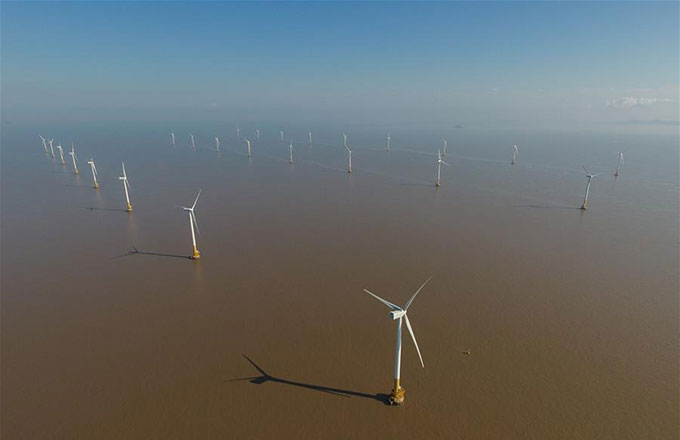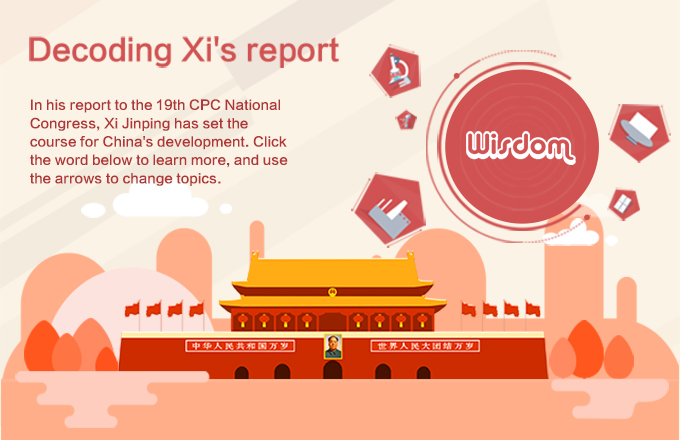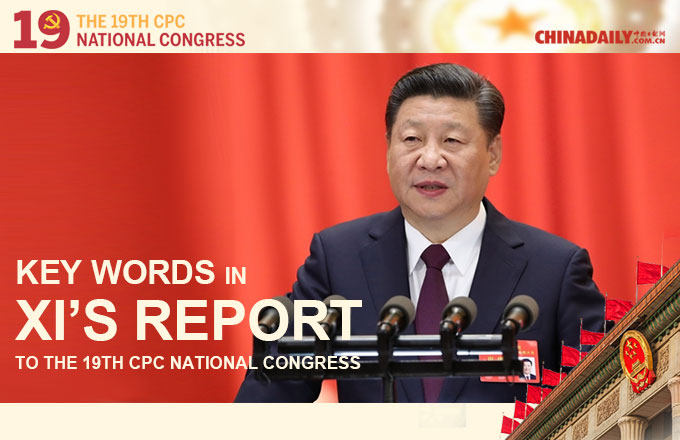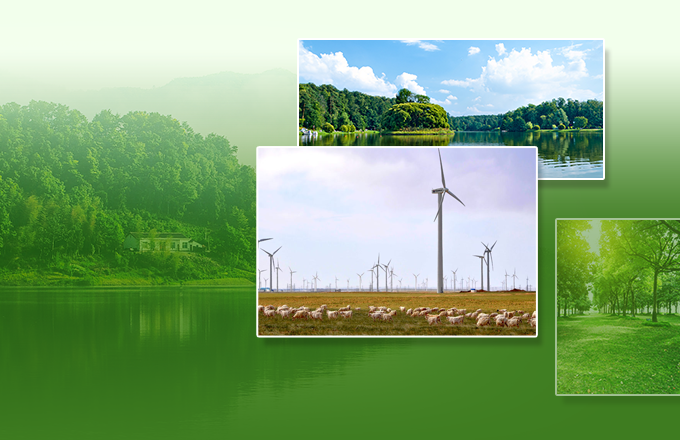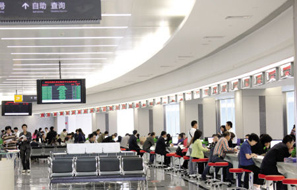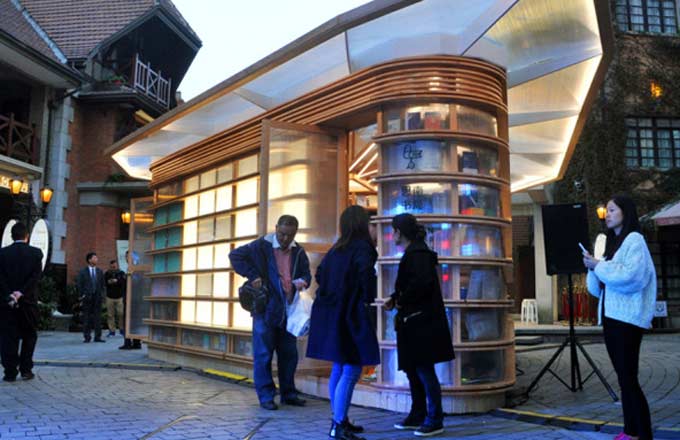Green growth
China sees a clean environment as the path forward toward an upgraded industrial structure
President Xi Jinping has summed up China's strategy for economic restructuring as striving for both "green mountains and gold mountains". The strategy combines environmental protection with a broad plan to restructure industry toward higher value-added manufacturing, away from the old reliance on heavy industry, resource extraction and low-tech steel and coal production.
"Given China's realities, ecological and economic developments both are of great significance because ecological development helps economic development in the long run," Xi said at the recent 19th National Congress of the Communist Party of China.
"The country should protect the environment like one protects one's eyes and treat the environment as one treats one's life," he stressed in May at a study session of the Political Bureau of the CPC Central Committee.
Often, environmental regulations are seen as just a necessary cost for the economy. China's strategy argues that a clean environment is the path forward toward an upgraded industrial structure. Far from being a cost, environmentally friendly pol-icy is a key opportunity. In other words, it pays to be green.
New higher-tech industries will not only produce the higher-quality products demanded by China's growing middle class. The shift toward investment in environmental protection could also allow many Chinese companies to gain a first-mover advantage in many innovative products that will be needed to improve the environment worldwide.
At the May study session, Xi said: "China has made historic social and economic achievements since reform and opening-up, which the country should be proud of. Rapid development has also left the country with environmental issues that need to be remedied through great efforts. To push green development and green lifestyles, the country should adopt a new development philosophy and correctly handle the relationship between economic development and environmental protection. China should firmly reject development models that damage or destroy the environment and bid farewell to practices that boost short-term economic growth at the cost of the environment."
This is consistent with the so-called Porter hypothesis. Professor Michael Porter of Harvard Business School argues that strict environmental regulation triggers the discovery and introduction of cleaner technologies and environmental improvements. Cost savings can more than compensate for both the compliance costs directly attributed to new regulations and the innovation costs. In addition, innovative companies can get a leg up on international competition.
The 19th CPC National Congress made clear that the administration sees implementation of this two-pronged economic strategy as a top priority. In his report to the congress on Oct 18, Xi mentioned the environment 89 times, as counted by Bloomberg - far more than any other subject. And he tied it to industrial restructuring: "We will move Chinese industries up to the medium-high end of the global value chain and foster a number of world-class advanced manufacturing clusters."
Since at least the 1980s, China has had anti-pollution regulations and environmental protection agencies at all levels of government. But during the decades of rapid economic transformation, the economy continued to be driven by heavily polluting industries such as coal, steel, cement, construction and cars. Many factories polluted with seeming impunity, and local governments gave priority to fast GDP growth of any kind. What has changed in the past five years?
Experts and practitioners in the field of environmental protection say that the leadership and systematic emphasis of Xi is a key transformative factor.
Yang Dongning, professor of economics at the Guanghua School of Management of Peking University, says: "Previous policies with a green focus were not systematic or consistent. When the pollution issue became very prominent, there would be 'storming' campaigns. But since the Xi administration started in 2013 and the 13th Five-Year Plan (2016-20) was approved, regulation has been systematic, rather than abrupt. Environmental inspection combined with Party discipline has led to very significant results."
Indu Bhushan, director-general for East Asia of the Asian Development Bank, says: "If you look at the policies and political commitment, it's right up there. President Xi talked about it five years ago, they have all the plans and targets in place. There is a lot of financing being put into it.
"Only a few years ago, ADB's work in China was largely focused on infrastructure. Now, if you look at our country program, there is not one single infrastructure project which is included only for infrastructure. The program is all about low-carbon development, green development, support for agriculture and for social sectors like preparing for an aging population and strengthening the social protection system. It is a huge change. When I was in China recently discussing our future program with the Ministry of Finance and the National Development and Reform Commission, they gave us 10 new projects - all related to the environment, climate change and social sectors," Bhushan added.
Similarly, Li Lailai, China country director of the World Resources Institute, says: "At the national level, the state leaders make a statement to the whole country, to the whole world. They created a framework within which practitioners like us can work to reach the goal. The statements in Xi Jinping's report are very important and significant. We practitioners need those statements."
Local efforts, obstacles
Chinese local government officials were long evaluated primarily on GDP growth rates, so environmental protection often was not a high priority. But GDP measures only monetary output. It does not take into account the quality or sustainability of the output. In addition, it ignores "negative externalities" that a complete accounting should subtract from production. Bhushan, of the ADB, says that studies conclude that accounting for pollution should lower China's GDP by 6 to 13 percent.
The new environmental protection law that went into effect on Jan 1, 2015, was a huge turning point. The new law was reviewed four times by the Standing Committee of the National People's Congress, while the government solicited feedback from environmental law experts, government bodies, local environmental protection bureaus and the public. The law created a much more powerful enforcement bureaucracy, held officials responsible for the environment and created formal channels for public participation in environmental protection.
Previously, local environmental protection bureaus reported to the local government and were dependent on local taxes for funding. Under the new law, they report to and are funded by higher levels of government.
Follow-on regulations in May 2015 mandated that all local officials be held responsible for environmental outcomes under their control. No longer just responsible for GDP growth, their promotions depend on the outcome of an in-depth environmental responsibility audit.
Li, of the World Resources Institute, says: "The most obvious change is environmental inspection. It is very large-scale and in-depth, involving so many people and the government at so many different levels. Institutionally, the vertical reporting system of the Environmental Protection Bureau helps enforcement. The new environment law of 2015 is one of the strictest in the world. It traces responsibilities not only to polluters, but also to investors and the government officials who approved the projects. They have responsibility no matter how much time has passed. Banks also need to be very cautious - they now require disclosure of environmental information."
There are still local pressures to support existing businesses and jobs. But some officials welcome the change and are finding innovative new approaches.
Yang, of PKU, points to the city of Jieyang, in South China's Guangdong province, which is a leading center for manufacturing stainless steel products. The city has around 4,000 stainless steel companies, with over 200,000 workers. Starting in 2013, the city government and an association of the companies worked together to build a new wastewater treatment center and acid treatment center. Now, many of the smaller, undercapitalized companies have closed and the others have moved toward higher-quality products that can command prices high enough to pay for the investment.
The city has now attracted investment from more than 30 high-tech environmental protection companies from Germany and other European countries. While some workers lost their jobs, many were hired by the upgraded factories and others received retraining assistance.
Another key problem is getting provinces to cooperate with each other. For example, much electricity generated by wind or solar power is wasted because provinces don't want to buy power from another province. China has made huge investments in wind and solar power, but about 17 percent of that capacity is curtailed. That is, it is not actually used, according to Greenpeace.
In 2016, Xu Jintao, professor of economics and associate dean at the National School of Development at Peking University, carried out a high-priority project for the NDRC to get to the bottom of the problem. He found that the boundaries between provinces and other administrative regions were the root cause. "The reality is that who gets what electricity is a decision of the provincial governments. It is very hard to break this provincial/local market," he said.
Similarly, the Asian Development Bank found that reducing pollution in rivers is difficult because upstream provinces may not have the incentive to invest the kind of money needed, since the negative affects mostly afflict downstream provinces. Bhushan of the ADB says the bank is now working on a framework called "equal compensation" under which provinces would share the costs.
There is an ongoing debate about the role of State-owned versus private enterprises, and large versus small companies, in the new upgraded economy. Some see large SOEs as being in a position to reform because they can invest the capital needed for new technology. Others emphasize that incentives to the private sector are key.
Xu, of PKU, argues: "We still have huge polluting industries that receive a subsidy amounting to about 1 percent of GDP. To change the industry structure, we need to remove all the subsidies and equalize the opportunities. We have huge discrimination against the private sector and small business". Xu especially welcomed the new tax on pollution, which will be implemented in January.
The fundamental restructuring of the economy is expected to be difficult, especially in North China, where many jobs and companies were built around the old economy.
Bhushan, of the ADB, says: "People being laid off from State-owned enterprises have been adequately supported in their transition out of their jobs. For SMEs and the informal sector, no such support system exists. The workers being laid off are not old enough to retire and they are not young enough to pick up other jobs without being reskilled. Here, China has to very seriously put in place retraining and redeployment plans.
"This is easier said than done, however. The kinds of skills required for the new economy are not easily acquired. One of the challenges China faces, which also came up in President Xi's address, is the increasing inequality. These people are the poster children of inequality - people who are being left behind in the growth process."
Focus on job creation
He Lifeng, director of the National Development and Reform Commission, says the economic growth target set for 2017 is both necessary and attainable. The target is necessary because job creation is an important task, he says, adding, "According to our experience, each percentage point of GDP growth will help create about 1.7 million jobs."
Li Ganjie, minister of environmental protection, says: "We are fully aware of the problems we are facing. Coal accounts for a high proportion of the overall energy mix. We have too many commodities transported by trucks. Some companies avoid emission control measures. Some local governments are not enforcing measures from the central government."
However, he says, environmental protection does not slow economic growth. "The ministry has closely tracked economic data of provinces that have launched environmental inspection, which showed that special measures to enforce environmental law have no negative impacts on economic growth. Those provinces even showed more sound growth momentum, including improved GDP, fiscal, foreign trade and employment rates," he says.
"Instead of harming economic development, environmental protection and green development thought, as explained by CPC Central Committee General Secretary Xi Jinping in his report to the Party congress, will further consolidate the economic growth foundation and achieve much more sustainable development," he adds.
davidblair@chinadaily.com.cn







